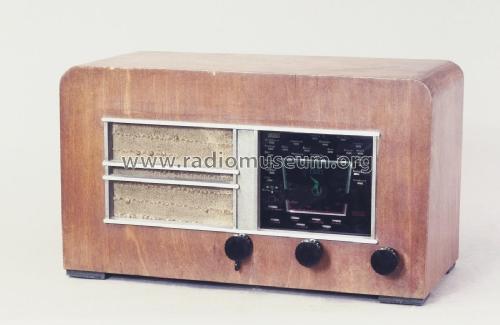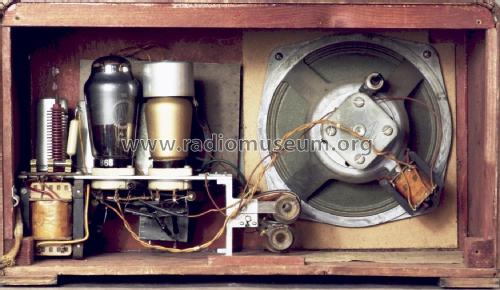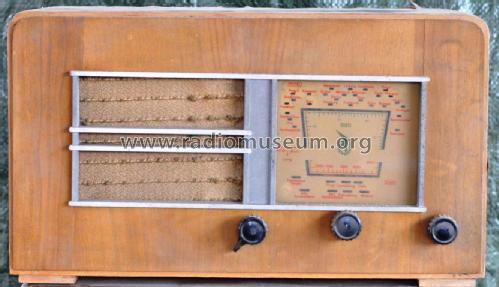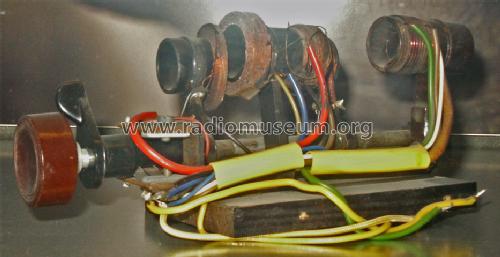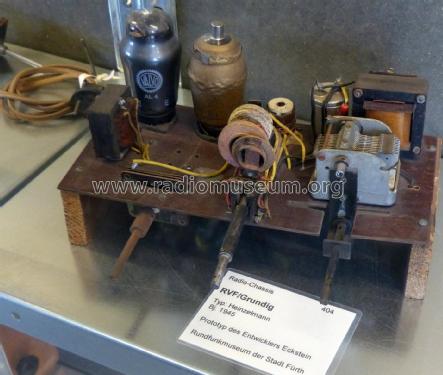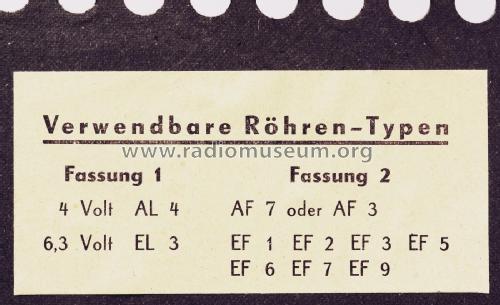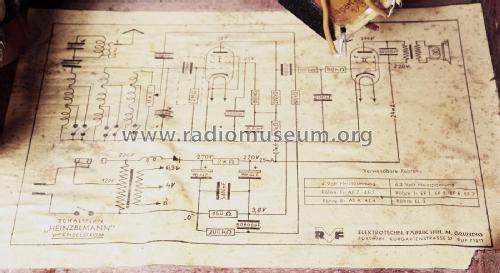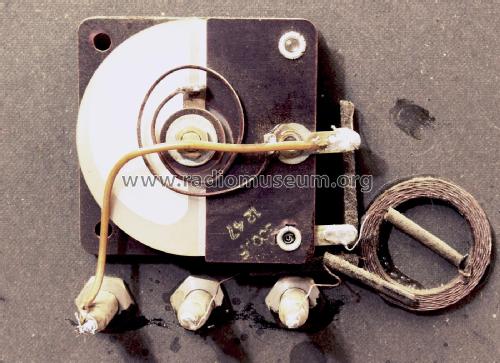Heinzelmann W 4 Volt
Grundig (Radio-Vertrieb, RVF, Radiowerke)
- Pays
- Allemagne
- Fabricant / Marque
- Grundig (Radio-Vertrieb, RVF, Radiowerke)
- Année
- 1946–1948
- Catégorie
- Radio - ou tuner d'après la guerre 1939-45
- Radiomuseum.org ID
- 1824
-
- alternative name: Grundig Portugal || Grundig USA / Lextronix
Cliquez sur la vignette du schéma pour le demander en tant que document gratuit.
- No. de tubes
- 2
- No. de transistors
- Semi-conducteurs
- Selengleichrichter
- Principe général
- Récepteur TRF - par réaction (régénératif); 1 Etage(s) BF
- Circuits accordés
- 1 Circuits MA (AM)
- Gammes d'ondes
- PO, GO et OC
- Tension / type courant
- Alimentation Courant Alternatif (CA) / 120/220 Volt
- Haut-parleur
- HP dynamique à aimant permanent + bobine mobile / Ø 17 cm = 6.7 inch
- Matière
- Boitier en bois
- De Radiomuseum.org
- Modèle: Heinzelmann W [4 Volt] - Grundig Radio-Vertrieb, RVF,
- Forme
- Modèle de table profil bas (grand modèle).
- Dimensions (LHP)
- 425 x 250 x 220 mm / 16.7 x 9.8 x 8.7 inch
- Remarques
-
1. Baukasten; diverse Röhren verwendbar; 4-V-Trafo.
Hier finden Sie etwas zum Radioprogramm von Grundig.
und hier: Die Techniken der Heinzelmänner von RVF und GRUNDIG
- Poids net
- 4.5 kg / 9 lb 14.6 oz (9.912 lb)
- Source
- Radiokatalog Band 1, Ernst Erb
- Source du schéma
- Lange-Nowisch
- Littérature
- Funkschau (10/1978, S. 442 - 445 / Bericht Max Grundig 70 Jahre)
- Schémathèque (1)
- -- Schematic
- Index des illustrations
- Das Gerät ist im Doppelband "Historische Radios" von Günther Abele abgebildet.
- D'autres Modèles
-
Vous pourrez trouver sous ce lien 6196 modèles d'appareils, 5420 avec des images et 4191 avec des schémas.
Tous les appareils de Grundig (Radio-Vertrieb, RVF, Radiowerke)
Collections
Le modèle Heinzelmann fait partie des collections des membres suivants.
Musées
Le modèle Heinzelmann peut être vu dans les musées suivants.
Contributions du forum pour ce modèle: Grundig Radio-: Heinzelmann W
Discussions: 4 | Publications: 22
Hallo Radiofreunde,
Wurde der Grundig Heinzelmann Baukasten "RVF-Baukasten W der Serie 2" auch mit unbedruckten Rückwänden verkauft?
Pièces jointes
- Grundig Heinzelmann W_Rückwand (74 KB)
- Grundig Heinzelmann W_Rückwand innen (61 KB)
Dieter ADAM, 29.Jan.14
Ich meine. Wenn man schon einen Spulensatz aus dem Museum in Fuerth hier einstellt, bzw. vorstellt,
kann man auch einen Artikel zum Heinzelmann, aus der Zeitschrift Rundfunk und Museum des Fördervereins am Museum in Fürth hier vorstellen.
knoll
Hans M. Knoll, 31.Jul.11
Fellow radiophiles,
I have recently been reading several accounts, mostly by our Hans Knoll, of the post-war story of the "Heinzelmann" line of radios made at RVF-Grundig starting around 1946.
The design of these radios appears to be the continuation of the DKE (Deutche Klein Emfaenger) series of radios before the war, that were built around a regenerative triode or tetrode detector front end and a power tetrode driving intially a high impedance reed speaker, then later a moving coil speaker with an audio transformer. The prewar half wave rectifier tube gave way to the selenium rectifier in the Heinzelman radios.
If I understand correctly from the German language account given by Hans Knoll, the last of these single tuned circuit radios was the Grundig Gloria 51W, that derived it's name from the model line of Lumophon that had been acquired by Grundig in 1951.
My question is: Where did the "Heinzelmann" name come from, and does it have a special meaning in German that does not come across in a translation by Google?
Best regards,
-Joe
Joe Sousa, 11.Jul.10
Ich bin kein Kenner der verschiedenen Grundig- "Heinzelmänner", nur ist mir beim lesen eines Artikels in der Funkschau Heft 1/1947 aufgefallen, dass dort statt der hier beim Modell genannten RGN1064 ein Trockengleichrichter aufgeführt ist. Hier auszugsweise der Kopf des Artikels:

Liegt hier irgend ein Fehler vor oder gab es Varianten, die nicht alle im RM gelistet sind?
W.E.
Wolfgang Eckardt, 25.Mar.08

